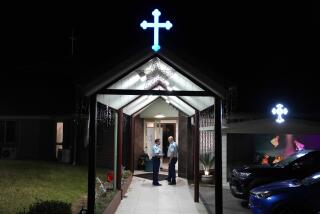Guantanamo, stateside
Life-size human silhouettes cut from orange cardboard direct passersby at busy Bayfront Park to the latest effort by human rights groups to get the Guantanamo prison for terrorism suspects shut down.
A replica of a maximum-security Camp 5 cell from the detention site at the U.S. naval base in Guantanamo Bay is at the center of an exhibit that opened Thursday in Miami and will tour major U.S. cities through summer.
Rights advocates from Amnesty International USA, the American Civil Liberties Union and the American Bar Assn. appealed to Washington to end what they see as an international embarrassment and breach of law.
“The U.S. government has made it impossible for people to get to Guantanamo to see this, so we wanted to bring a bit of the reality to the public,” said Larry Cox, executive director of Amnesty International USA. “To stand inside this cell gives them some sense of the psychological hell of being held in a box for years and not knowing if you’ll ever get out.”
Organizers of the tour say that more than six years into the controversial detention and trial operations, Guantanamo has become a remote concept for most U.S. citizens.
“I’ve seen Guantanamo close up and personal . . . and that’s convinced me that there has never been a greater threat to the rule of law than what we have at Guantanamo now,” said Neal R. Sonnett, head of the American Bar Assn. task force on the treatment of enemy combatants and its observer at the Guantanamo war court.
The 7-by-10-foot cell painted orange and emblazoned with the words “Counter Terror With Justice” was built by Amnesty International of Australia for a campaign there two years ago to get Australian detainee David Hicks released from Guantanamo, said Amnesty’s Jumana Musa, also a tribunal observer.
The specifications for the cell -- white-walled and containing only a benchlike bunk, steel sink and toilet -- were once posted on the Defense Department’s website but have since been removed, she noted.
Hicks, one of the first terrorism suspects captured in Afghanistan and brought to Guantanamo, was released to the Australian government in spring 2007 after a plea bargain reduced the charges against him. He served a nine-month sentence in Adelaide, Australia, and was freed in December.
The touring exhibit is intended to draw attention to Guantanamo as the Pentagon prepares for the first U.S. war-crimes trial in 60 years at the end of this month. Salim Ahmed Hamdan, a Yemeni who worked as Osama bin Laden’s $200-a-month driver in Afghanistan, faces charges of conspiracy and material support to terrorism. If convicted, he could be sentenced to life in prison. Pentagon officials have said they plan to prosecute about 80 of the 270 men still at Guantanamo.
The first cells, chain-link pens topped with razor wire, were erected and filled in January 2002. Subsequent camps built at the base in southern Cuba have been concrete-and-steel facilities modeled on prisons in Michigan and Indiana.
As the cell exhibit was unveiled Thursday, people strolling the waterfront recreation area flanking the high-rises of downtown Miami wandered over for a peek. David Galarca, an 18-year-old from North Miami, said he didn’t know much about Guantanamo. The cell exhibit stirred his interest, he said. Then he wandered back to the waterfront with his friends.
“We are from Italy, and we -- many Europeans -- don’t understand why the United States is doing this,” said Cesare Longo, a Roman in Miami for his honeymoon. “The problem we have with Guantanamo is that the justice there isn’t the same as in the United States. They should make the same guarantees for the people they accuse of terrorist acts as they do for people in the United States.”
Some passersby shouted derisive comments and expletives at the exhibit and at the dozen or so demonstrators who showed up in orange jumpsuits similar to those worn by Guantanamo detainees in the first years the prison was in operation.
“What kind of due process did they get in 9/11, buddy?” a middle-aged man shouted at Sonnett as he cut across the grassy field behind the pavilion where the lawyer was speaking.
The human rights groups have planned a seven-hour concert at the Miami cell site Saturday, before the exhibit moves on to Philadelphia.
--
More to Read
Start your day right
Sign up for Essential California for news, features and recommendations from the L.A. Times and beyond in your inbox six days a week.
You may occasionally receive promotional content from the Los Angeles Times.







